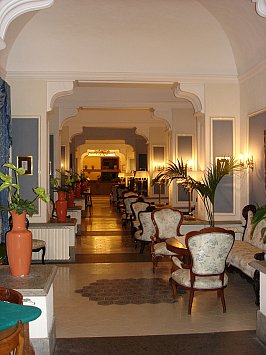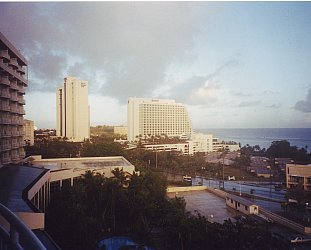Graham Reid | | 6 min read

Over cocktails Lionello -- who owns a luxury hotel in Sorrento -- insists we go to his friend Gennaro’s restaurant.
“He is a master, he has a gift,” he says enthusiastically, advising us away from his own dining room which had, the previous night, offered food that redefined the word sublime.
“But is he fat?” I joke. “I don’t trust a thin chef.”
Lionello laughs: “Oh yes, Gennaro is a big man.”
Megan and I are the only two guests in Dr Lionello del Papa’s 50-room Grand Hotel Cocumella which occupies a balcony seat in the pretty town of Sorrento across the bay from Naples.
It is late in the season and, although the skies are cloudless and the weather still balmy, most tourists have gone home. The usually crowded streets of Sorrento are comparatively deserted. And we have Cocumella -- with its sommelier, two chefs, waiters, and Lionello -- all to ourselves.
We walk to our suite down spacious marble halls between gilt-framed mirrors and antique furnishings. The place is as silent as the moon and I’m thinking this could the perfect place to settle in and write that long -overdue novel -- but images of Jack Nicholson going quietly crazy in The Shining keep coming to mind.
We do nothing for days.
Late one afternoon I am relaxing with Lionello on the terrace beside the elegant restaurant.
We have just returned from a stroll down the leafy path to the end of the property -- the blue pool on one side shaded by orange trees, the olive grove on the other -- where I have audibly gasped at the view across the Bay of Naples from the white walkway along the edge of the cliff.
Before us in the heat-haze distance was Vesuvius and below, maybe 100 metres down a sheer drop, the sea beside the hotel’s solarium had been transparent. A couple of people with snorkels paddling around leisurely.
Around us butterflies and bees hovered in the late summer heat.
It had been a breathtaking view and the experience -- when added to the luxury of the historic Cocumella -- confirmed why this charming place attracts visitors of all persuasions.
Wildman rocker Iggy Pop has stayed here, says Lionello. “He was very quiet, would have one beer and be in bed by 10.30. Robert Plant of Led Zeppelin came and no one knew who he was.”
The Duke of Wellington was a guest here even further back.
That is the kind of place Cocumella is, a retreat from the world where you are left to enjoy the luxurious ambience of the rooms and dining areas, the extensive wine cellar and gourmet menu.
The Jesuits who built this place in the 16th century -- it was converted to a hotel in 1822 -- obviously had a sense of humour: the place is named for the nymph Colomelide. However one of their learned number later, perhaps out of sensitivity, insisted the name referred to the terracotta vase used in the region to hold the water, a cuccuma.
In fact the stone well used to take water from the underlying cistern, which dates back to the Roman era, remains at the centre of the hotel’s cloister.
Nearby is the old private chapel which is today used for concerts.
The hotel is Lionello’s happy inheritance. His late father, an architect, redesigned the original hotel more than a decade ago to turn it into something discreetly opulent -- it is a member of the Small Luxury Hotels of the World group -- where every room is different.
And of course nearby Sorrento, named for the Greek sirens who lured sailors to their deaths, is the city which drew Goethe, Homer, Byron, Keats, Dickens -- and these days hundreds of thousands of tourists. It is a five minute walk away.
Cocumella however -- with its sun-drenched terrace, elevator down to the sea and tennis courts -- is situated well away from the drag strip which is the Corso Italia.
After a day at Pompeii we retreat to our antique-filled room with its balcony and glimpse of the blue Bay of Naples until dinner in the Scintilla Restaurant with its patio view across the small fragrant park.
Dinner arrives: escalope of swordfish in sesame with crushed almonds; whole scampi with handmade angel hair pasta wrapped around it and small potato wedges in a saffron sauce; half a lobster and porcini mushrooms with more handmade pasta; mushroom-filled ravioli pasta with a delicate herb sauce; lemon sorbet to give us a breather and refresh the palate . . .
And that is before the main course of pan fried fish with a light crispy coating and steamed vegetables, then the desert of pastries . . .
Yet the following afternoon Lionello is insisting we go to Gennaro’s?
And so that night a taxi takes us on a winding half hour drive through impossibly narrow lanes, over the hill and down to the port village of Vico Equense and Gennaro’s restaurant on the harbour‘s edge.
Here in an old Saracen tower is his intimate and beautiful Torre del Saracino Ristorante, where the cellar stocks over 1200 wines.
From Naples south, seafood is the thing to eat. Fat octopi, huge prawns, tasty cockles and white, and full-bodied fish such as dentix (like sea bream) are pulled from the Mediterranean, some more salty than Southern Hemisphere palates are familiar with.
Gennaro emerges from his kitchen to greet us. Even without the white apron we would have recognised him.
He is portly, beaming and effortlessly charming. And young.
Gennaro is a member of the Jeunes Restaurateurs d’Europe, an organisation dedicated to bringing young restaurateurs to greater attention. Their motto is “talent and passion”, and their website (www.jre.net) offers travellers a route planner and booking system to allow for a gourmet tour of Europe.
The defining features of these restaurants, we are told by our sommelier Luciano, is they offer fine dining, an extensive wine list to compliment the food, a convivial atmosphere, and chefs who care.
Gennaro cares so much he disappears quickly back into his kitchen, Luciano chooses an introductory local rose, and within a minute a taster arrives: a coil of raw swordfish in tomato water.
Our waiter has recommended some special dishes from the menu and so we sit back, let Luciano do his work, and savour what comes. It is astonishing.
Thin, ribbon-like lasagne pasta wrapped around squid, red prawns and sea bass; ravioli of swordfish with spring onions, capers and olives served with herbs and lemon; dentix with courgettes; and unusual pasta of different thicknesses from nearby Gragnano in the mountains with a white grouper ragout in a sweet and sour lemon sauce . . .
Luciano compliments all these with wines which include a soft white from the ancient Greco-Roman city of Paestum further south near Palermo, and an especially full bodied local red to accompany the truffle and porcini salad.
The food is absurdly good and beautifully presented, and we are about to admit defeat when dessert arrives: a selection of mini tartlets, chocolate truffles and jelly with thin twigs of bitter dark chocolate and mini meringues. It is arranged on a long white platter in a minimalist Japanese design.
We are almost embarrassed by these culinary riches, and the company in the room: other than us the dozen other diners look like ambassadors, retired bankers, the discreetly moneyed.
When we have finished Gennaro invites us to join him outside and so on a breezy night in the shadow of an ancient tower with the fishing boats bobbing before us we sit, feeling like characters in someone else’s dream.
Gennaro is jovial as he sucks down cigarettes, and we ask him about the odd pasta of different thicknesses.
“They are each one handmade by two old ladies in a nearby village, so no two pieces are the same. They only make 10 kilos a day -- and they only sell them to friends.”
Compliments on the meal seem shallow, no matter how genuinely effusive, so I buy him and his sous-chef a bottle of wine of their choosing. He thanks me, and diplomatically picks a New Zealand chardonnay from his cellar.
We soak up the night, a rare one, and Gennaro assures us through cigarettes and gulps of wine that business is good.
Megan is chilly so he rushes off and finds a bright yellow scarf to wrap around her. She looks like a beacon in the night.
In the taxi on the way home we are lost for words, and no better the next day when Lionello asks me if we enjoyed our meal.
The words don’t come out right, but I tell him that in all honesty it had been one of the finest -- if not the finest -- meals I have ever had. It was a concordance of tastes and textures in an atmosphere which was refined but relaxed, historic yet contemporary.
I tell Lionello that it had been prepared by a young and gifted chef -- and one whose physique suggests he enjoyed good food.
“No,” Lionello laughs. “He loves Pringles, he eats them all the time. That is why he is big like he is. It is the Pringles!“
For other travel stories by Graham Reid, see here for his two award-winning travel books.







Lance Stamps - Jun 9, 2011
Well written Graham.
SaveThe hotel is such a Jewel!
post a comment